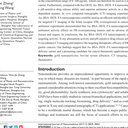Effects of Fentanyl on Emergence Agitation in Children under Sevoflurane Anesthesia: Meta-Analysis of Randomized Controlled Trials.
Keywords
Abstract
OBJECTIVE
The goal of this meta-analysis study was to assess the effects of fentanyl on emergence agitation (EA) under sevoflurane anesthesia in children.
METHODS
We searched electronic databases (PubMed, Embase, Web of Science and the Cochrane Central Register of Controlled Trials) for articles published until December 2014. Randomized controlled trials (RCTs) that assessed the effects of fentanyl and placebo on EA under sevoflurane anesthesia in children that the outcome were the incidence of EA, postoperative pain, emergence time or adverse effects were included in this meta-analysis.
RESULTS
A total of 16 studies, including 1362 patients (737 patients for the fentanyl group and 625 for the placebo group), were evaluated in final analysis. We found that administration of fentanyl decreased the incidences of EA (RR = 0.37, 95% CI 0.27~0.49, P<0.00001) and postoperative pain (RR = 0.59, 95% CI 0.41~0.85, P = 0.004) but increased the incidence of postoperative nausea and vomiting (PONV) (RR = 2.23, 95% CI 1.33~3.77, P = 0.003). The extubation time (WMD = 0.71 min, 95% CI 0.12~1.3, P = 0.02), emergence time (WMD = 4.90 min, 95% CI 2.49~7.30, P<0.0001), and time in the postanesthesia care unit (PACU) (WMD = 2.65 min, 95% CI 0.76~4.53, P = 0.006) were slightly increased. There were no significant differences in the time to discharge of day patients (WMD = 3.72 min, 95% CI -2.80~10.24, P = 0.26).
CONCLUSIONS
Our meta-analysis suggests that fentanyl decreases the incidence of EA under sevoflurane anesthesia in children and postoperative pain, but has a higher incidence of PONV. Considering the inherent limitations of the included studies, more RCTs with extensive follow-up should be performed to validate our findings in the future.



